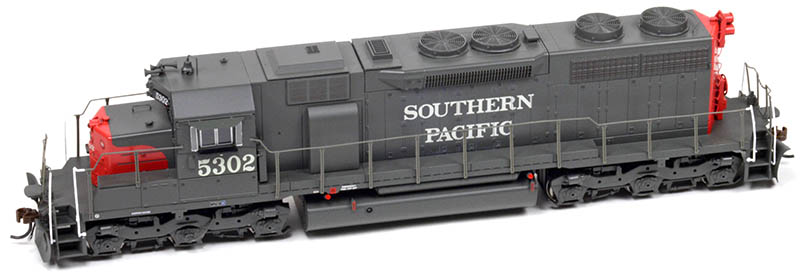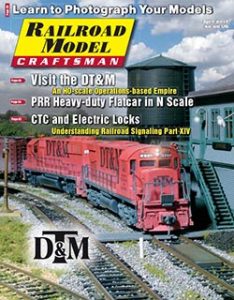 By Dennis Dunning
By Dennis Dunning
Following its initial production run of the all-new HO-scale EMD SD39 in schemes such as Santa Fe; Illinois Terminal; Minneapolis, Northfield & Southern, Athearn Trains has finally released its SD39 for Southern Pacific, complete with a plethora of road-specific details unique to this western road. Athearn offers four different road numbers (5302, 5306, 5310, 5314) for Southern Pacific — enough to satisfy most any aficionado of the Espee.
In 1966, General Motors’ Electro-Motive Division (EMD) introduced its Super Duty (SD) six-axle C-C locomotives with a new 645-series diesel prime mover at a variety of different horsepower ratings to serve a wide range of customer service requirements. At the top end of the range for high-speed freight service was the 3,600-hp SD45 with a 20-cylinder turbocharged 645 and the 3,000- hp SD40 with a turbocharged 16-cylinder 645 prime mover. On the lower end of the range for low-speed hauling was the 2,000-hp naturally aspirated 16-cylinder SD38. In 1968, EMD added the SD39 with a medium horsepower V12 to its model line. The new SD39 was billed as an alternative to the 2,000-hp SD38. The SD39, with 2,300-hp, was less powerful than the more popular SD40 but provided more power than the 2,000-hp SD38, and with a lower fuel consumption rate.
The SD39 was designed for use as a medium-duty road switcher, with 2,300 hp, giving it an opportunity to find favor with railroads that preferred low-speed lugging capability eschewing higher horsepower for higher speeds. Only four railroads bought the SD39. Santa Fe and Southern Pacific acquired the lion’s share of those units for helper service over high-altitude mountain passes. Santa Fe purchased 20 units, Illinois Terminal bought six, and Minneapolis, Northfield & Southern added two to its roster. The largest purchaser was Southern Pacific in two orders: 18 locomotives (5300–5317) in late 1968 and eight more (5318–5325) in 1970. With the introduction of EMD’s improved DASH-2 line in 1972, production of the SD39 ceased. The SD39 shared the same 65- foot, 9½-inch long frame with the SD38, SD40, and SD45, but the length of the long hood and end platforms remained the same as the SD40 and SD38 despite the shorter 12-cylinder prime mover. As a result, one of the most notable spotting features of the SD39 from the SD38 and SD40 is the pronounced blank space behind the cab ahead of the inertial filter compartment.
An interesting side note to the SD39 was its smaller cousin, the SDL39. The Milwaukee Road asked EMD to design a lightweight diesel locomotive to replace some aging units used on granger branch lines with light-duty infrastructure. Ten SDL39s were produced. After the wreck of the Milwaukee 581, the nine remaining units transitioned to ownership under SOO Line and Wisconsin Central before being sold overseas to FEPASA in Chile.
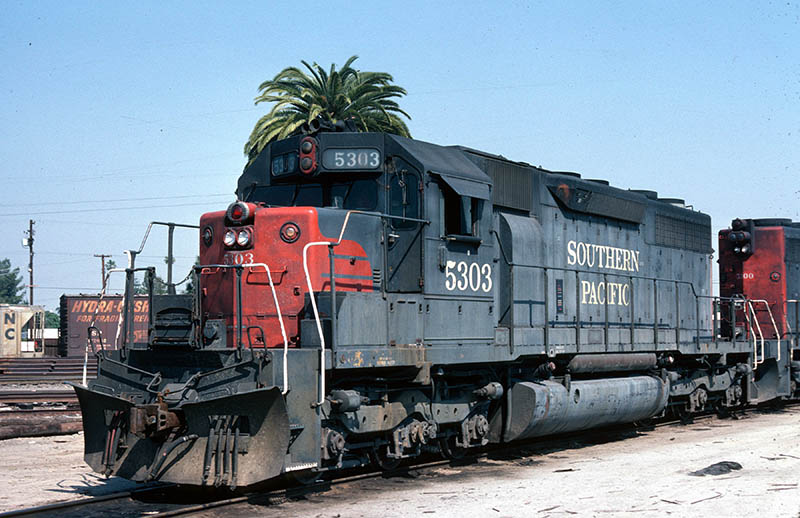
Southern Pacific SD39 5303 shows its age, but still has many years of work left. This image was taken in March 1979 view at Anaheim, Calif. — Francis Wiener photo, Kevin EuDaly collection
As mentioned earlier, this SP release of the SD39 from Athearn is available in four different road numbers. Each road number is offered in two flavors — either with DCC and a Tsunami Sound unit, or a lower-priced DC models with a DCC-ready quick-plug. Railroad Model Craftsman’s review sample was road number 5302 with DCC and sound (#98887, MSRP: $189.98). Another release expected later this year will offer four additional road numbers to represent SP’s final order of eight SD39s with different spotting features. As with this release, each of the road numbers will be offered in Sound/DCC versions, as well as DC versions easily upgradable to full DCC control.
The model is supplied in the standard Athearn blue and yellow cardstock box, with the locomotive itself nestled in a clear plastic clamshell container encased in foam. There are dense foam strips between the body and the handrails to protect these parts. The handrails appear delicate but are actually quite strong, flexible, and straight. Should the handrails come loose from the body shell, they push right back into their respective holes. If you want to glue in any loose stanchions, I would recommend the use of Pacer Formula 560 Canopy Glue for the job. Foam inserts on the top and the bottom of the clamshell case help protect the model in transit. RMC’s sample slid out of the plastic container in perfect condition.
A word of caution: The dynamic brake assembly at the top of the body snaps loosely into place. Do not attempt to pick the unit up from the dynamic brake area because it releases easily, and the model could take a nasty fall. As with most diesel models, it is best to pick them up with your fingers beneath the fuel tanks. There is a double-sided, illustrated parts list included in the box that shows each part and where it goes. Should you be missing a part, or need to replace one due to an accident, contact information is supplied for Athearn’s Customer Service Department.
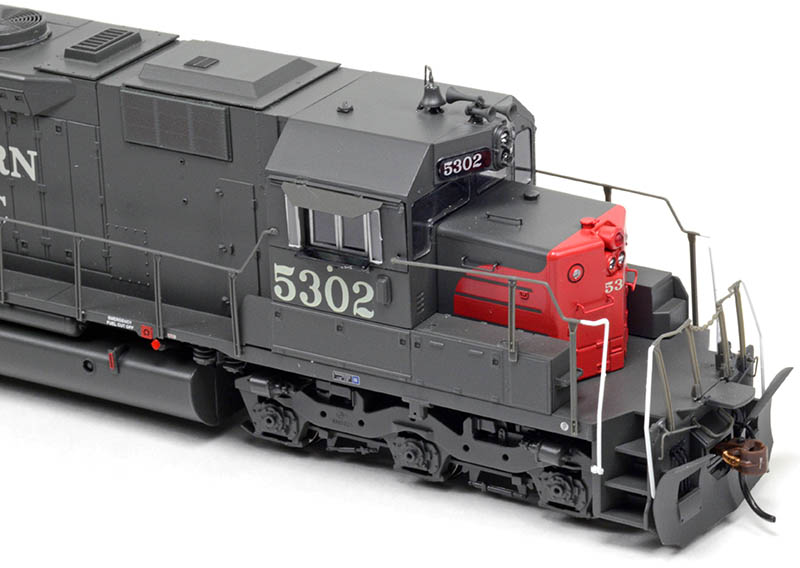
The model is beautiful out of the box — it captures the lines of the prototype perfectly, and the main dark gray body and red nose match photos of SP’s SD39s extremely well. Though this model is in Athearn’s Ready To Roll series, the detailing is still excellent. Contrary to popular belief, this is an all-new model from the wheels up, featuring all-new tooling for all body, truck sideframes, and underframe components. Because the body is molded with the deck as a single unit, readers should understand that is impossible for deck tread to be included on this single-piece long hood with deck. Nevertheless, the fidelity of the detail is almost on par with Athearn’s own higher-end offerings in the Genesis line. In terms of body details, about the only things separating this RTR model from a Genesis-series model are the lack of deck tread, absence of lift rings atop the hood, no windshield wipers, and much sparser detail on the underframe of the model.
The handrails along the side of the body, and at the end of the front and rear decks have a delicate look and are sized correctly, unlike offerings found elsewhere in the marketplace. They handrail assemblies are finished in nearly the same gray as the body, with the handrails at the stepwells finished in white matching prototype photos. There are individual wire grab irons preinstalled at each end of the body. As with most of Athearn’s recent locomotive releases, the wire grab irons measure out to scale thickness, yet are sturdy to the touch. Nice!
Large snow plow pilots (a common sight on Southern Pacific diesels of the era) are mounted at each end of the body shell and are crisply molded. MU hoses are preinstalled behind each opening of each snow plow. However, for an as-delivered SP SD39, the MU hoses should be a four-hose cluster instead of the three-hose clusters that are found on the model. Drop steps are located atop each pilot fixed in the down position, and tall MU stands are mounted as separate moldings adjacent to the drop step. The front of the cab has the correct L-shaped window on the engineer’s side, while both sides of the cab windows have large armrests and sunshades. A sturdy brass Nathan P3 horn cluster resides on top of the cab with two bells facing forward and one facing the rear. The SP-style roof-mounted bell even has the very fine airline attached. The rear of the model features a brake wheel and stand on the rear platform, and the end of the long hood does not have number boards. All of these details are correct to prototype and are beautifully executed.
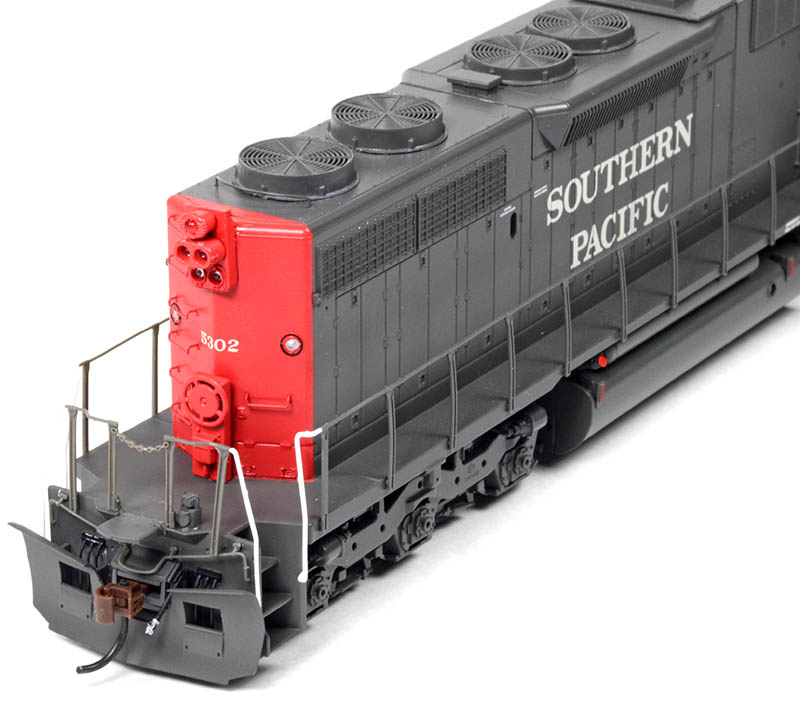
Headlights front and rear follow Southern Pacific practice. The nose has the correct three-light cluster, with a dual- lens clear gyralite mounted vertically between the number boards. The lighting is directionally controlled. The front number boards have very crisp printed numbers, though they are not illuminated. The rear of the body features a large headlight cluster that includes a duallens headlight, a dual sealed beam clear gyralite, and a single-lens red gyralite — all mounted on a large bracket. The red gyralites at each end of the unit are represented with red lenses and are not illuminated.
Body details are finely rendered with all the access doors exhibiting crisp seams and nicely represented small hinges and door latches. The blower housing on the fireman’s side of the body is the correct version lacking reinforcement ribs, and the inertial intake grilles are also the proper early corrugated version. Toward the back of the long hood, the radiator grilles are of the fine-mesh FARR style with excellent definition. Of all the SD39s ever produced, only Southern Pacific specified the extra-cost Farr radiator grilles. It is wonderful to see Athearn capture this unique feature so accurately. The dynamic brake section has the proper profile and extended-range access door, and the 48-inch dynamic brake fans feature etched stainless grilles mounted firmly above the fan blades. A rectangular dynamic brake vent is also provided aft of the dynamic brake fans. The turbo stack is separately applied from the factory. The turbo stack is open to allow for ventilation of heat per the prototype, and the provided ventilation is also quite welcome on our model as well!
Asides from the Farr radiator grilles, a signature feature of SP’s first group of SD39s (SP 5300–5317) are the large ballast blocks found on either side of the short nose up front. Built for helper service over SP’s tortuous line over the Tehachapi Mountains, SP specified extra weight be added to maximize the amount of tractive effort possible from its SD39s. These distinctive blocks are found on the model as well. Additionally, SP presciently specified a water level sight glass to be present on the long hood on the engineer’s side. This feature was later made standard across all EMD’s subsequent DASH-2 line introduced in 1972. Athearn has done an exemplary job capturing all these critical nuances unique to the flavor of SP’s first group of SD39s.

As mentioned earlier, Athearn will be offering a new production run of SP SD39s scheduled for release later in 2017. With an additional four road numbers, this second run of SP SD39s will be constructed to represent SP’s second group of SD39s numbered from 5318– 5325. On the prototype, and as expected on the model, this final order of SP SD39s should feature smaller ballast blocks than the first order of SP SD39s as reviewed here. Also, the second group features split-sub-base doors underneath the cab instead of a single wide door as found on SP 5300–5317. For this second run, Athearn is also expected to provide the large 21-inch “SP” block lettering on the nose of these units.
With all SD39s, one of the most noticeable fittings on EMD units are the massive fuel tanks. These 4,000-gallon tanks capture EMD’s late-second generation production fuel tank profile very well. On the model, each tank is cast in styrene with separately applied fuel filler nozzles and a vertical sight glass displaying the amount of fuel in the tank. Corresponding to Southern Pacific specifications of the period, Athearn astutely provides a second set of fuel fillers and vertical fuel gauges installed at the rear of the tank as well. In addition, a parts bag is included with additional vent and drain pipes that can be added to the fuel tank by the modeler. A diagram on the instruction sheet shows where the various fittings go, though it does not differentiate from one road’s practice to the other, and I found it hard to see these from the angle most photos are taken. Air reservoirs are also installed above the fuel tanks but affixed to the edges of the body shell.
The three-axle Flexicoil-C2H trucks feature very good detailing with brake rigging visible and separately applied high-mounted brake cylinders at the outboard corners of each sideframe. The truck sideframes and details are cast in styrene and mounted to each truck mechanism.
The paint and lettering on the model are quite good except for one glaring error with the 5302. On this model, Athearn has correctly captured the Lark Dark Gray and SP Scarlet standard on all Southern Pacific diesels after 1958. The paint is applied smoothly with the correct amount of coverage so as not to obscure any of the finer details. The Lettering Gray of the “SOUTHERN PACIFIC” Roman lettering is printed in an opaque fashion. However, the large “5302” road numbers under the cab windows should be 15 inches in height, but instead are vastly oversize and do not conform to any prototype photos of the SP 5302 or of any other SP SD39 that I have ever observed. The small five-inch road numbers on each end of the hood and seveninch numbers on the number boards are printed crisply and legibly. The “Emergency Fuel Cut Off” lettering above the fuel tank is perfect, even under magnification. The fuel filler caps are highlighted in red, as are the vertical fuel gauges. It should be noted that the cab side lettering discrepancy is only a problem with the 5302 road number in this release. I would instead recommend getting any of the other road numbers for SP in this release because they are correct.
Unlike earlier recent Athearn RTR releases, the cab side windows are a single-piece molding glued in place, instead of separately positionable sliding window panes. In terms of ease of use, this may be simpler for some consumers, but those customers hoping to pose a waving engineer inside or simply want an open or partially open window are in for a much bigger battle than before. What is worse, is that the new single piece window molding is undersized. The window molding is too narrow from side to side and too much sash from top to bottom. Not only do the outer edges of the window sashes appear in full, but a physical gap exists between the edges of the window molding and the side of the cab, allowing air to pass through. Knowing this, I and many others prefer the positionable window panes to this latest incarnation.
This unit is powered by Athearn’s standard RTR motor. The motor has flywheels on each end with the shafts driving gear towers on each truck to power all six axles. The extremely quiet-running unit (with the sound turned off, obviously) performs very smoothly. I did not observe any hesitancy nor wobble of any kind. For those who insist, the frame will easily accept a Genesis motor upgrade, available separately from Athearn. The model weighs 15.3 ounces, and all the wheel measurements conformed with my NMRA Standards gauge. The SD39 is equipped with Kadee-compatible McHenry plastic scale-head spring-knuckle couplers that can be easily changed to a coupler of your choice.
With this sound/DCC-equipped version, I tested the SD39 in d.c. first. There is nothing additional needed for use with d.c. At about four volts, the diesel’s prime mover sound effects begin. At six volts, the locomotive begins to move. Much like momentum power on d.c., the locomotive gradually picks up speed as the throttle is increased. It slows down the same way, so you must plan your stop long before you arrive. Once the power is turned off, the diesel motor sound continues and gradually decreases until it finally shuts off. During forward operations, the sound system intermittently generates a horn sound; there is always a bell sound when the locomotive moves in reverse. However, there is no slow speed while using d.c. If you are not going to be using the DCC features, I would forego the sound/DCC version and buy the DCCready d.c. version; chances are, you’ll be much happier with the performance.
The locomotive is a dream to operate under DCC control. Crack the throttle just barely, and the locomotive will begin creeping along at about 2–3 scale mph. As you increase the power, the speed seems to top out at about 85 miles per hour. The SoundTraxx Econami sound module provides excellent sound effects, especially the prime mover sound. Athearn does not provide any information within the box on the operation of the sound unit, but you can find out all the various functions by going to the SoundTraxx website. The bell, whistle, brake squeal, and so forth are found on the usual function buttons, but you may have to experiment to get some of the lesser-used sounds.
Southern Pacific modelers are in for a real treat with this locomotive. With its unique SP-only features, Athearn’s rendition of the SP SD39 really captures all the subtle nuances of this signature Espee locomotive. Though its numbers were comparatively small on the large roster of the Espee, examples of SP’s SD39 fleet were commonly seen at popular rail fan destinations all over Southern California such as Tehachapi, Cajon Pass, and well beyond. Athearn’s Southern Pacific SD39 is beautifully detailed, and its running qualities are as good as it gets. With the use of DCC and accompanying sound, adding this unit to your HO main line will be well worth it.
Athearn Trains
1600 Forbes Way, Suite 120
Long Beach CA 90810
(310) 763-7140


